Marketing Mix Report
VerifiedAdded on 2019/12/03
|8
|2143
|204
Report
AI Summary
This report provides a comprehensive analysis of the marketing mix, also known as the 4Ps (Product, Price, Place, and Promotion). It begins by defining marketing and introducing the concept of the marketing mix as a strategic tool for businesses. The report then delves into a detailed explanation of each of the 4Ps, illustrating their importance in formulating effective marketing strategies. A case study is presented, focusing on the application of the 4Ps to market a healthy smoothie product to young students (aged 11-21). The case study outlines specific strategies for product development, pricing, distribution, and promotion tailored to the target demographic. The report concludes by summarizing the key takeaways, emphasizing the significance of the marketing mix as a tool for analyzing marketing effectiveness and achieving success in the marketplace. The report also includes a list of references to support its claims and analysis.

MARKETING MIX
1
1
Paraphrase This Document
Need a fresh take? Get an instant paraphrase of this document with our AI Paraphraser

Table of Contents
INTRODUCTION ...............................................................................................................................3
1.1 Marketing Mix...........................................................................................................................3
1.2 Marketing mix as a tool of analysis...........................................................................................4
1.3 Applying 4 Ps to market the proposed product..........................................................................5
Conclusion............................................................................................................................................6
References............................................................................................................................................7
2
INTRODUCTION ...............................................................................................................................3
1.1 Marketing Mix...........................................................................................................................3
1.2 Marketing mix as a tool of analysis...........................................................................................4
1.3 Applying 4 Ps to market the proposed product..........................................................................5
Conclusion............................................................................................................................................6
References............................................................................................................................................7
2
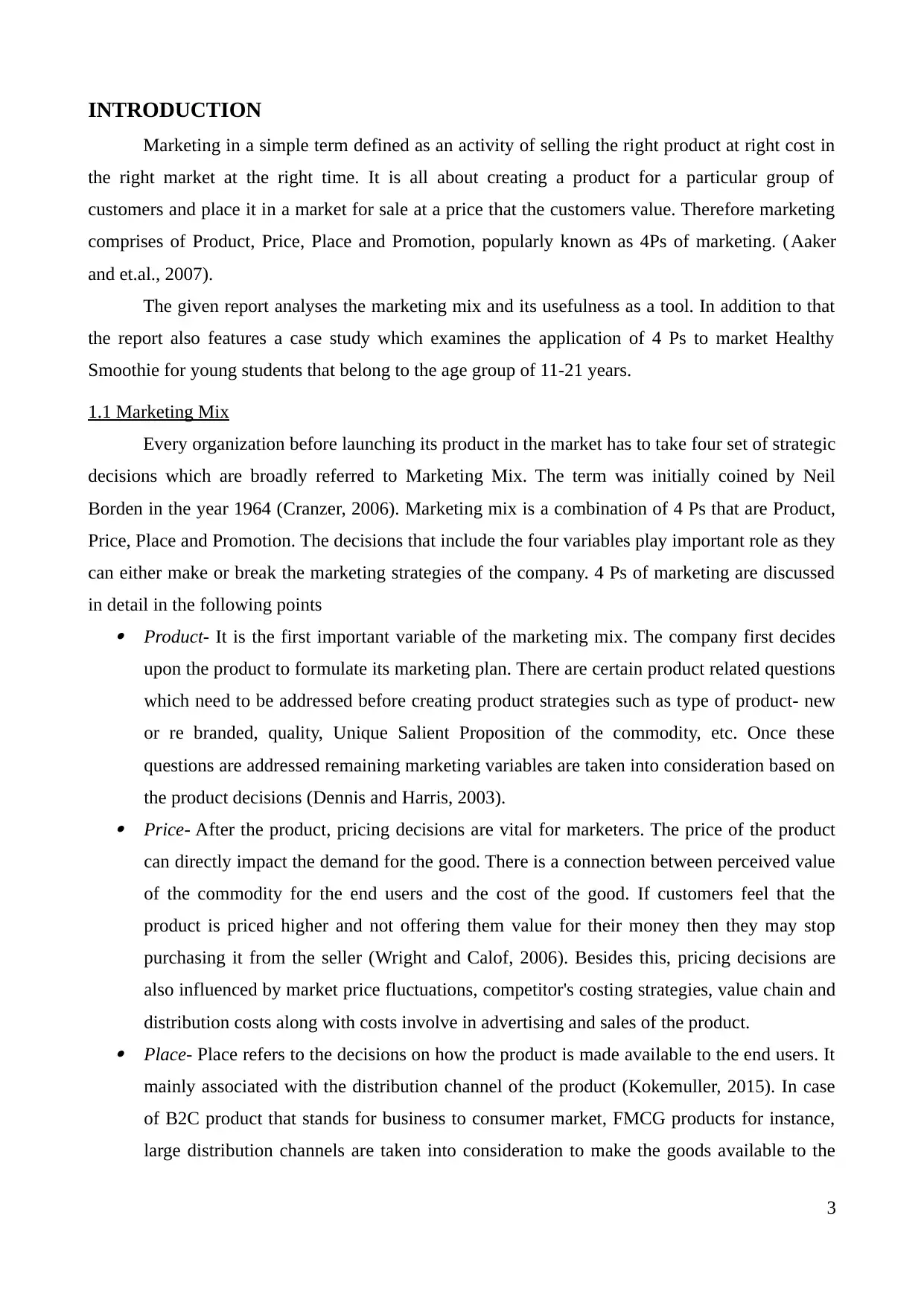
INTRODUCTION
Marketing in a simple term defined as an activity of selling the right product at right cost in
the right market at the right time. It is all about creating a product for a particular group of
customers and place it in a market for sale at a price that the customers value. Therefore marketing
comprises of Product, Price, Place and Promotion, popularly known as 4Ps of marketing. (Aaker
and et.al., 2007).
The given report analyses the marketing mix and its usefulness as a tool. In addition to that
the report also features a case study which examines the application of 4 Ps to market Healthy
Smoothie for young students that belong to the age group of 11-21 years.
1.1 Marketing Mix
Every organization before launching its product in the market has to take four set of strategic
decisions which are broadly referred to Marketing Mix. The term was initially coined by Neil
Borden in the year 1964 (Cranzer, 2006). Marketing mix is a combination of 4 Ps that are Product,
Price, Place and Promotion. The decisions that include the four variables play important role as they
can either make or break the marketing strategies of the company. 4 Ps of marketing are discussed
in detail in the following points Product- It is the first important variable of the marketing mix. The company first decides
upon the product to formulate its marketing plan. There are certain product related questions
which need to be addressed before creating product strategies such as type of product- new
or re branded, quality, Unique Salient Proposition of the commodity, etc. Once these
questions are addressed remaining marketing variables are taken into consideration based on
the product decisions (Dennis and Harris, 2003). Price- After the product, pricing decisions are vital for marketers. The price of the product
can directly impact the demand for the good. There is a connection between perceived value
of the commodity for the end users and the cost of the good. If customers feel that the
product is priced higher and not offering them value for their money then they may stop
purchasing it from the seller (Wright and Calof, 2006). Besides this, pricing decisions are
also influenced by market price fluctuations, competitor's costing strategies, value chain and
distribution costs along with costs involve in advertising and sales of the product. Place- Place refers to the decisions on how the product is made available to the end users. It
mainly associated with the distribution channel of the product (Kokemuller, 2015). In case
of B2C product that stands for business to consumer market, FMCG products for instance,
large distribution channels are taken into consideration to make the goods available to the
3
Marketing in a simple term defined as an activity of selling the right product at right cost in
the right market at the right time. It is all about creating a product for a particular group of
customers and place it in a market for sale at a price that the customers value. Therefore marketing
comprises of Product, Price, Place and Promotion, popularly known as 4Ps of marketing. (Aaker
and et.al., 2007).
The given report analyses the marketing mix and its usefulness as a tool. In addition to that
the report also features a case study which examines the application of 4 Ps to market Healthy
Smoothie for young students that belong to the age group of 11-21 years.
1.1 Marketing Mix
Every organization before launching its product in the market has to take four set of strategic
decisions which are broadly referred to Marketing Mix. The term was initially coined by Neil
Borden in the year 1964 (Cranzer, 2006). Marketing mix is a combination of 4 Ps that are Product,
Price, Place and Promotion. The decisions that include the four variables play important role as they
can either make or break the marketing strategies of the company. 4 Ps of marketing are discussed
in detail in the following points Product- It is the first important variable of the marketing mix. The company first decides
upon the product to formulate its marketing plan. There are certain product related questions
which need to be addressed before creating product strategies such as type of product- new
or re branded, quality, Unique Salient Proposition of the commodity, etc. Once these
questions are addressed remaining marketing variables are taken into consideration based on
the product decisions (Dennis and Harris, 2003). Price- After the product, pricing decisions are vital for marketers. The price of the product
can directly impact the demand for the good. There is a connection between perceived value
of the commodity for the end users and the cost of the good. If customers feel that the
product is priced higher and not offering them value for their money then they may stop
purchasing it from the seller (Wright and Calof, 2006). Besides this, pricing decisions are
also influenced by market price fluctuations, competitor's costing strategies, value chain and
distribution costs along with costs involve in advertising and sales of the product. Place- Place refers to the decisions on how the product is made available to the end users. It
mainly associated with the distribution channel of the product (Kokemuller, 2015). In case
of B2C product that stands for business to consumer market, FMCG products for instance,
large distribution channels are taken into consideration to make the goods available to the
3
⊘ This is a preview!⊘
Do you want full access?
Subscribe today to unlock all pages.

Trusted by 1+ million students worldwide
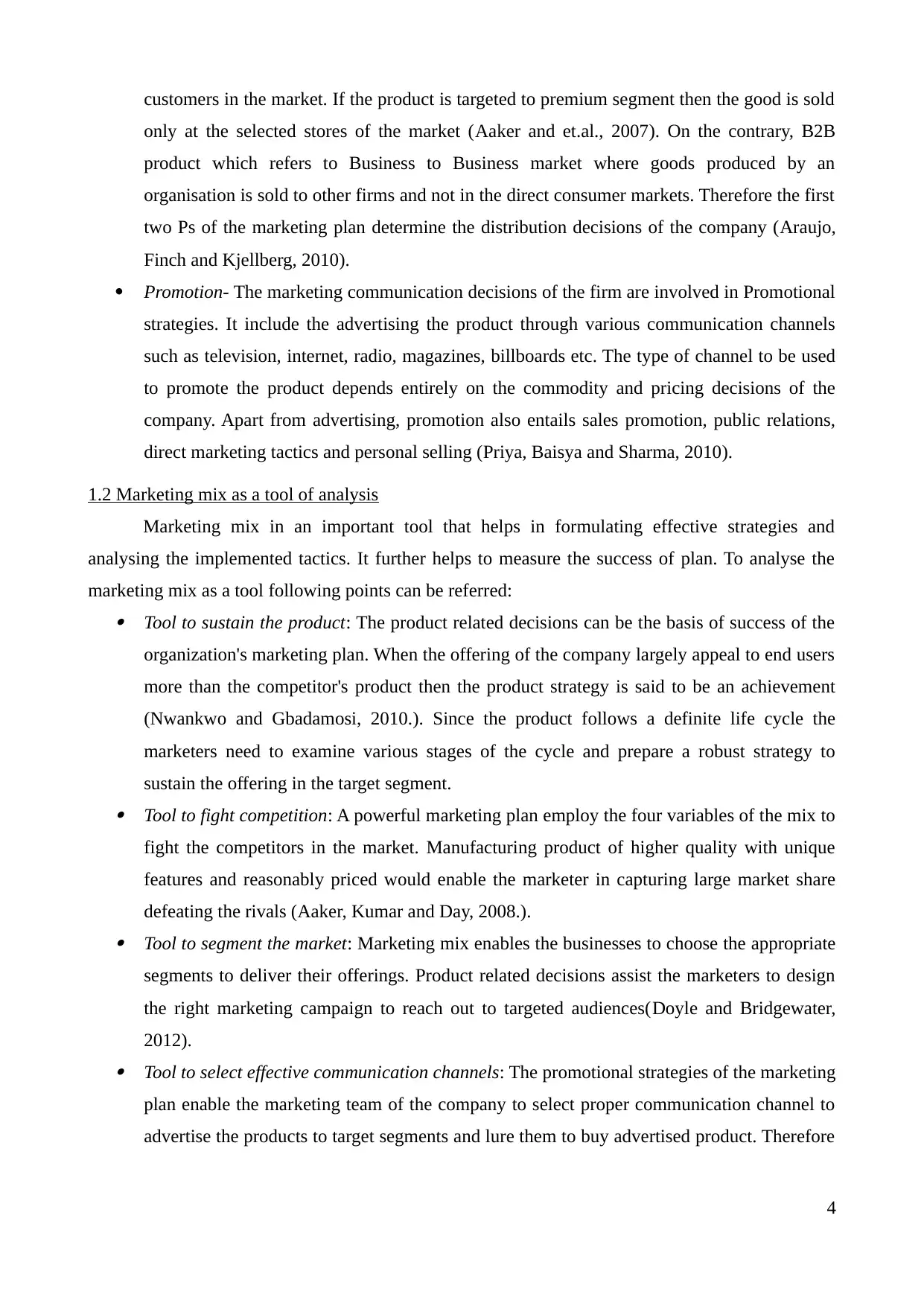
customers in the market. If the product is targeted to premium segment then the good is sold
only at the selected stores of the market (Aaker and et.al., 2007). On the contrary, B2B
product which refers to Business to Business market where goods produced by an
organisation is sold to other firms and not in the direct consumer markets. Therefore the first
two Ps of the marketing plan determine the distribution decisions of the company (Araujo,
Finch and Kjellberg, 2010).
Promotion- The marketing communication decisions of the firm are involved in Promotional
strategies. It include the advertising the product through various communication channels
such as television, internet, radio, magazines, billboards etc. The type of channel to be used
to promote the product depends entirely on the commodity and pricing decisions of the
company. Apart from advertising, promotion also entails sales promotion, public relations,
direct marketing tactics and personal selling (Priya, Baisya and Sharma, 2010).
1.2 Marketing mix as a tool of analysis
Marketing mix in an important tool that helps in formulating effective strategies and
analysing the implemented tactics. It further helps to measure the success of plan. To analyse the
marketing mix as a tool following points can be referred: Tool to sustain the product: The product related decisions can be the basis of success of the
organization's marketing plan. When the offering of the company largely appeal to end users
more than the competitor's product then the product strategy is said to be an achievement
(Nwankwo and Gbadamosi, 2010.). Since the product follows a definite life cycle the
marketers need to examine various stages of the cycle and prepare a robust strategy to
sustain the offering in the target segment. Tool to fight competition: A powerful marketing plan employ the four variables of the mix to
fight the competitors in the market. Manufacturing product of higher quality with unique
features and reasonably priced would enable the marketer in capturing large market share
defeating the rivals (Aaker, Kumar and Day, 2008.). Tool to segment the market: Marketing mix enables the businesses to choose the appropriate
segments to deliver their offerings. Product related decisions assist the marketers to design
the right marketing campaign to reach out to targeted audiences(Doyle and Bridgewater,
2012). Tool to select effective communication channels: The promotional strategies of the marketing
plan enable the marketing team of the company to select proper communication channel to
advertise the products to target segments and lure them to buy advertised product. Therefore
4
only at the selected stores of the market (Aaker and et.al., 2007). On the contrary, B2B
product which refers to Business to Business market where goods produced by an
organisation is sold to other firms and not in the direct consumer markets. Therefore the first
two Ps of the marketing plan determine the distribution decisions of the company (Araujo,
Finch and Kjellberg, 2010).
Promotion- The marketing communication decisions of the firm are involved in Promotional
strategies. It include the advertising the product through various communication channels
such as television, internet, radio, magazines, billboards etc. The type of channel to be used
to promote the product depends entirely on the commodity and pricing decisions of the
company. Apart from advertising, promotion also entails sales promotion, public relations,
direct marketing tactics and personal selling (Priya, Baisya and Sharma, 2010).
1.2 Marketing mix as a tool of analysis
Marketing mix in an important tool that helps in formulating effective strategies and
analysing the implemented tactics. It further helps to measure the success of plan. To analyse the
marketing mix as a tool following points can be referred: Tool to sustain the product: The product related decisions can be the basis of success of the
organization's marketing plan. When the offering of the company largely appeal to end users
more than the competitor's product then the product strategy is said to be an achievement
(Nwankwo and Gbadamosi, 2010.). Since the product follows a definite life cycle the
marketers need to examine various stages of the cycle and prepare a robust strategy to
sustain the offering in the target segment. Tool to fight competition: A powerful marketing plan employ the four variables of the mix to
fight the competitors in the market. Manufacturing product of higher quality with unique
features and reasonably priced would enable the marketer in capturing large market share
defeating the rivals (Aaker, Kumar and Day, 2008.). Tool to segment the market: Marketing mix enables the businesses to choose the appropriate
segments to deliver their offerings. Product related decisions assist the marketers to design
the right marketing campaign to reach out to targeted audiences(Doyle and Bridgewater,
2012). Tool to select effective communication channels: The promotional strategies of the marketing
plan enable the marketing team of the company to select proper communication channel to
advertise the products to target segments and lure them to buy advertised product. Therefore
4
Paraphrase This Document
Need a fresh take? Get an instant paraphrase of this document with our AI Paraphraser
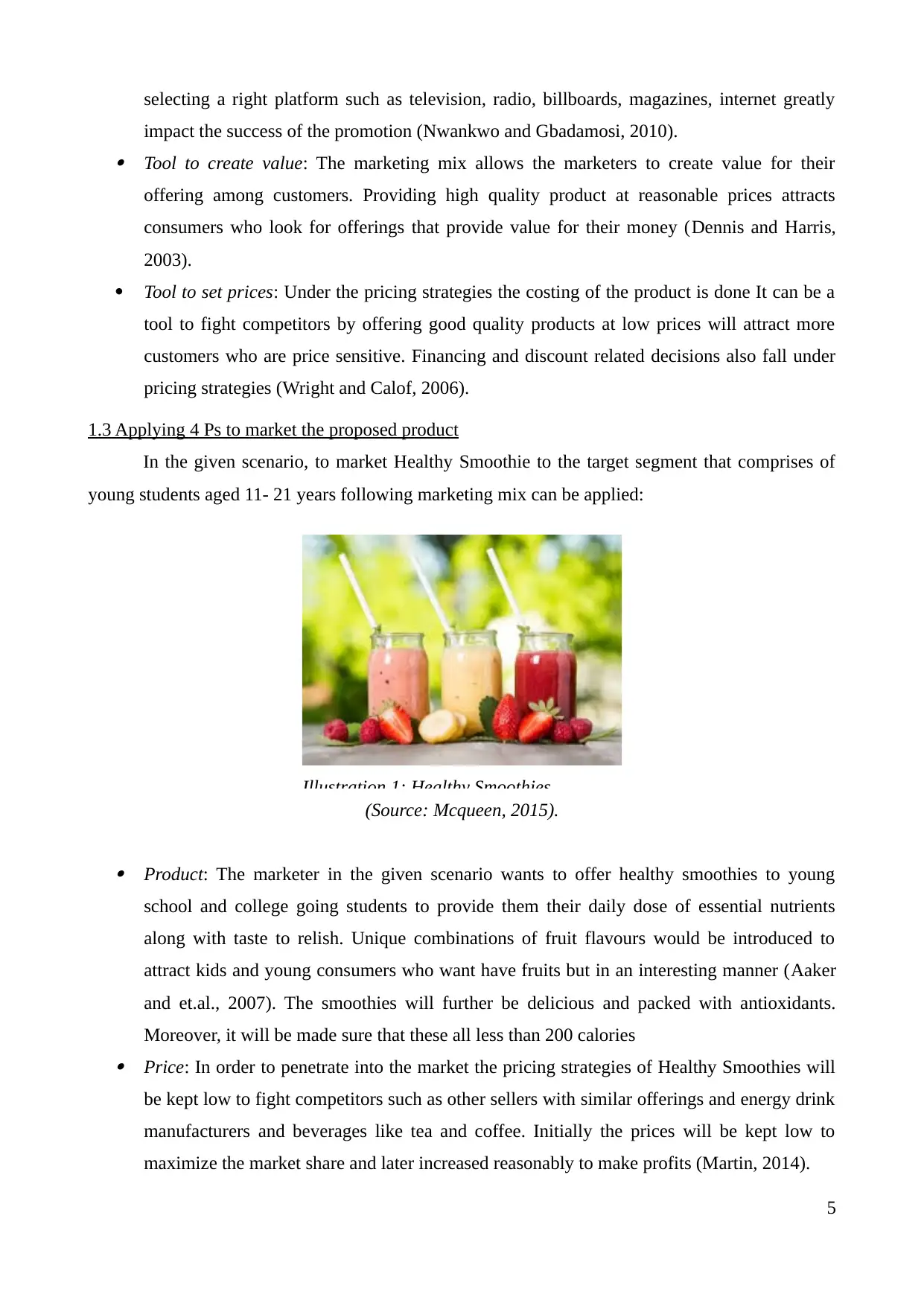
selecting a right platform such as television, radio, billboards, magazines, internet greatly
impact the success of the promotion (Nwankwo and Gbadamosi, 2010). Tool to create value: The marketing mix allows the marketers to create value for their
offering among customers. Providing high quality product at reasonable prices attracts
consumers who look for offerings that provide value for their money (Dennis and Harris,
2003).
Tool to set prices: Under the pricing strategies the costing of the product is done It can be a
tool to fight competitors by offering good quality products at low prices will attract more
customers who are price sensitive. Financing and discount related decisions also fall under
pricing strategies (Wright and Calof, 2006).
1.3 Applying 4 Ps to market the proposed product
In the given scenario, to market Healthy Smoothie to the target segment that comprises of
young students aged 11- 21 years following marketing mix can be applied:
(Source: Mcqueen, 2015).
Product: The marketer in the given scenario wants to offer healthy smoothies to young
school and college going students to provide them their daily dose of essential nutrients
along with taste to relish. Unique combinations of fruit flavours would be introduced to
attract kids and young consumers who want have fruits but in an interesting manner (Aaker
and et.al., 2007). The smoothies will further be delicious and packed with antioxidants.
Moreover, it will be made sure that these all less than 200 calories Price: In order to penetrate into the market the pricing strategies of Healthy Smoothies will
be kept low to fight competitors such as other sellers with similar offerings and energy drink
manufacturers and beverages like tea and coffee. Initially the prices will be kept low to
maximize the market share and later increased reasonably to make profits (Martin, 2014).
5
Illustration 1: Healthy Smoothies
impact the success of the promotion (Nwankwo and Gbadamosi, 2010). Tool to create value: The marketing mix allows the marketers to create value for their
offering among customers. Providing high quality product at reasonable prices attracts
consumers who look for offerings that provide value for their money (Dennis and Harris,
2003).
Tool to set prices: Under the pricing strategies the costing of the product is done It can be a
tool to fight competitors by offering good quality products at low prices will attract more
customers who are price sensitive. Financing and discount related decisions also fall under
pricing strategies (Wright and Calof, 2006).
1.3 Applying 4 Ps to market the proposed product
In the given scenario, to market Healthy Smoothie to the target segment that comprises of
young students aged 11- 21 years following marketing mix can be applied:
(Source: Mcqueen, 2015).
Product: The marketer in the given scenario wants to offer healthy smoothies to young
school and college going students to provide them their daily dose of essential nutrients
along with taste to relish. Unique combinations of fruit flavours would be introduced to
attract kids and young consumers who want have fruits but in an interesting manner (Aaker
and et.al., 2007). The smoothies will further be delicious and packed with antioxidants.
Moreover, it will be made sure that these all less than 200 calories Price: In order to penetrate into the market the pricing strategies of Healthy Smoothies will
be kept low to fight competitors such as other sellers with similar offerings and energy drink
manufacturers and beverages like tea and coffee. Initially the prices will be kept low to
maximize the market share and later increased reasonably to make profits (Martin, 2014).
5
Illustration 1: Healthy Smoothies
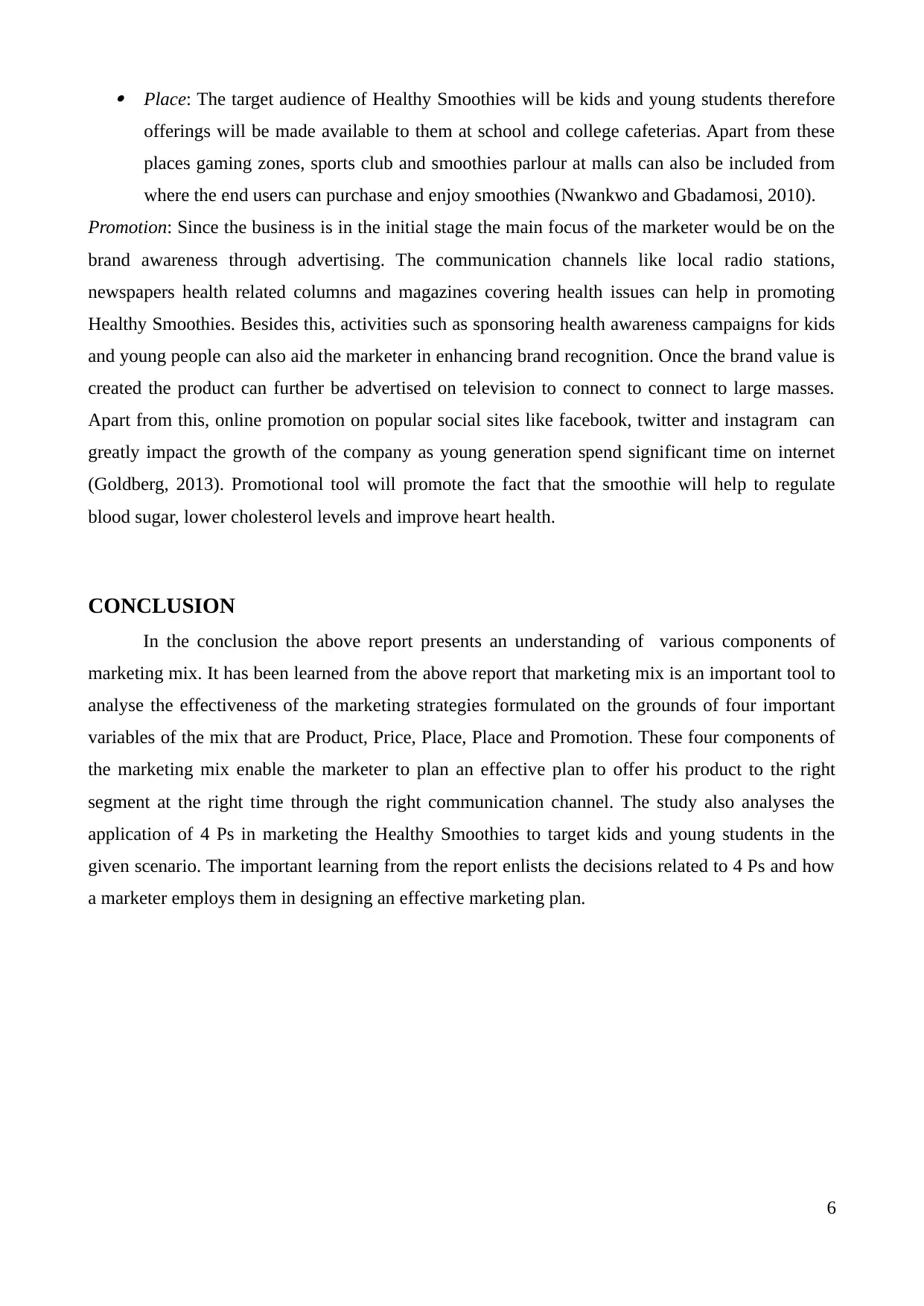
Place: The target audience of Healthy Smoothies will be kids and young students therefore
offerings will be made available to them at school and college cafeterias. Apart from these
places gaming zones, sports club and smoothies parlour at malls can also be included from
where the end users can purchase and enjoy smoothies (Nwankwo and Gbadamosi, 2010).
Promotion: Since the business is in the initial stage the main focus of the marketer would be on the
brand awareness through advertising. The communication channels like local radio stations,
newspapers health related columns and magazines covering health issues can help in promoting
Healthy Smoothies. Besides this, activities such as sponsoring health awareness campaigns for kids
and young people can also aid the marketer in enhancing brand recognition. Once the brand value is
created the product can further be advertised on television to connect to connect to large masses.
Apart from this, online promotion on popular social sites like facebook, twitter and instagram can
greatly impact the growth of the company as young generation spend significant time on internet
(Goldberg, 2013). Promotional tool will promote the fact that the smoothie will help to regulate
blood sugar, lower cholesterol levels and improve heart health.
CONCLUSION
In the conclusion the above report presents an understanding of various components of
marketing mix. It has been learned from the above report that marketing mix is an important tool to
analyse the effectiveness of the marketing strategies formulated on the grounds of four important
variables of the mix that are Product, Price, Place, Place and Promotion. These four components of
the marketing mix enable the marketer to plan an effective plan to offer his product to the right
segment at the right time through the right communication channel. The study also analyses the
application of 4 Ps in marketing the Healthy Smoothies to target kids and young students in the
given scenario. The important learning from the report enlists the decisions related to 4 Ps and how
a marketer employs them in designing an effective marketing plan.
6
offerings will be made available to them at school and college cafeterias. Apart from these
places gaming zones, sports club and smoothies parlour at malls can also be included from
where the end users can purchase and enjoy smoothies (Nwankwo and Gbadamosi, 2010).
Promotion: Since the business is in the initial stage the main focus of the marketer would be on the
brand awareness through advertising. The communication channels like local radio stations,
newspapers health related columns and magazines covering health issues can help in promoting
Healthy Smoothies. Besides this, activities such as sponsoring health awareness campaigns for kids
and young people can also aid the marketer in enhancing brand recognition. Once the brand value is
created the product can further be advertised on television to connect to connect to large masses.
Apart from this, online promotion on popular social sites like facebook, twitter and instagram can
greatly impact the growth of the company as young generation spend significant time on internet
(Goldberg, 2013). Promotional tool will promote the fact that the smoothie will help to regulate
blood sugar, lower cholesterol levels and improve heart health.
CONCLUSION
In the conclusion the above report presents an understanding of various components of
marketing mix. It has been learned from the above report that marketing mix is an important tool to
analyse the effectiveness of the marketing strategies formulated on the grounds of four important
variables of the mix that are Product, Price, Place, Place and Promotion. These four components of
the marketing mix enable the marketer to plan an effective plan to offer his product to the right
segment at the right time through the right communication channel. The study also analyses the
application of 4 Ps in marketing the Healthy Smoothies to target kids and young students in the
given scenario. The important learning from the report enlists the decisions related to 4 Ps and how
a marketer employs them in designing an effective marketing plan.
6
⊘ This is a preview!⊘
Do you want full access?
Subscribe today to unlock all pages.

Trusted by 1+ million students worldwide
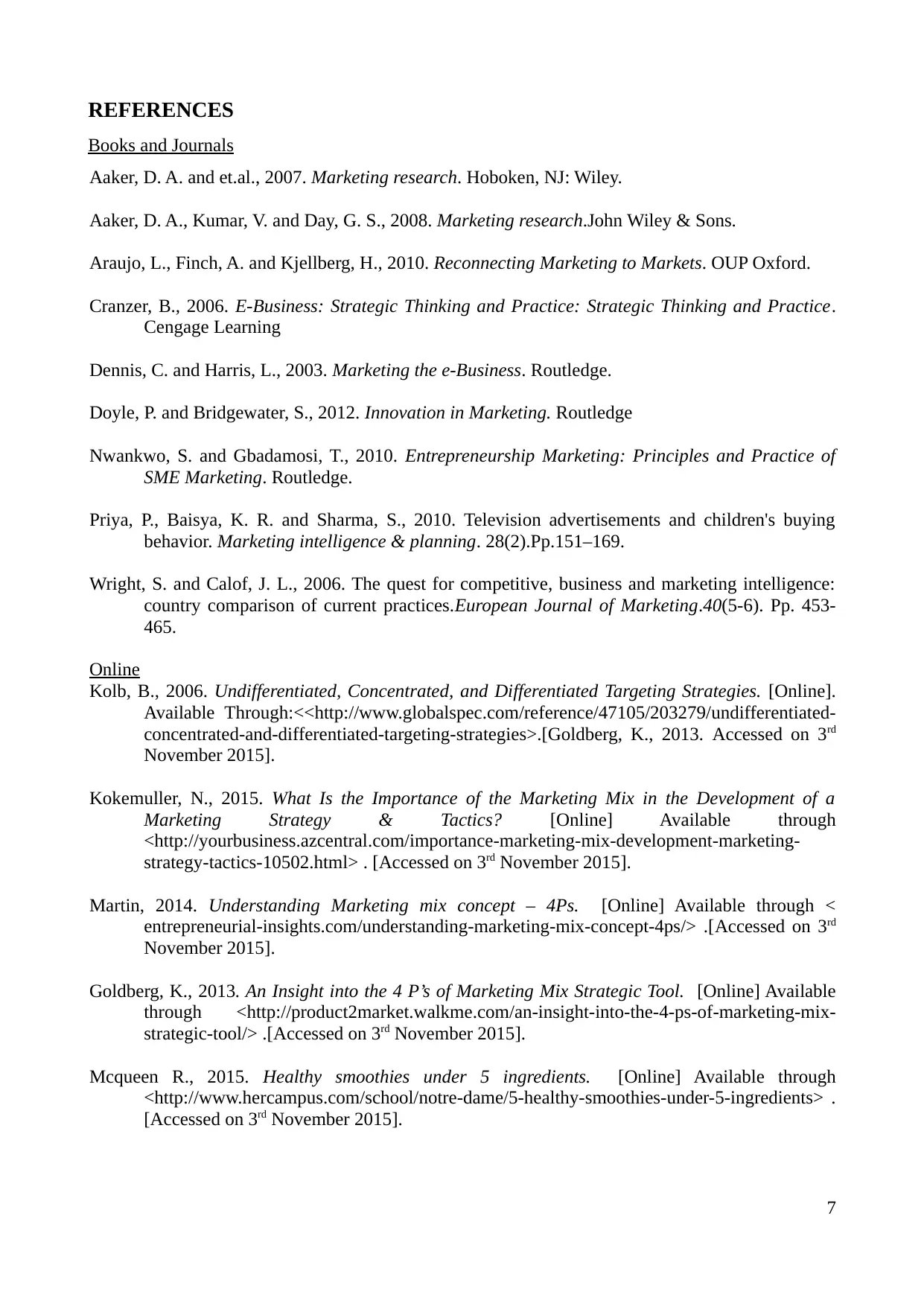
REFERENCES
Books and Journals
Aaker, D. A. and et.al., 2007. Marketing research. Hoboken, NJ: Wiley.
Aaker, D. A., Kumar, V. and Day, G. S., 2008. Marketing research.John Wiley & Sons.
Araujo, L., Finch, A. and Kjellberg, H., 2010. Reconnecting Marketing to Markets. OUP Oxford.
Cranzer, B., 2006. E-Business: Strategic Thinking and Practice: Strategic Thinking and Practice.
Cengage Learning
Dennis, C. and Harris, L., 2003. Marketing the e-Business. Routledge.
Doyle, P. and Bridgewater, S., 2012. Innovation in Marketing. Routledge
Nwankwo, S. and Gbadamosi, T., 2010. Entrepreneurship Marketing: Principles and Practice of
SME Marketing. Routledge.
Priya, P., Baisya, K. R. and Sharma, S., 2010. Television advertisements and children's buying
behavior. Marketing intelligence & planning. 28(2).Pp.151–169.
Wright, S. and Calof, J. L., 2006. The quest for competitive, business and marketing intelligence:
country comparison of current practices.European Journal of Marketing.40(5-6). Pp. 453-
465.
Online
Kolb, B., 2006. Undifferentiated, Concentrated, and Differentiated Targeting Strategies. [Online].
Available Through:<<http://www.globalspec.com/reference/47105/203279/undifferentiated-
concentrated-and-differentiated-targeting-strategies>.[Goldberg, K., 2013. Accessed on 3rd
November 2015].
Kokemuller, N., 2015. What Is the Importance of the Marketing Mix in the Development of a
Marketing Strategy & Tactics? [Online] Available through
<http://yourbusiness.azcentral.com/importance-marketing-mix-development-marketing-
strategy-tactics-10502.html> . [Accessed on 3rd November 2015].
Martin, 2014. Understanding Marketing mix concept – 4Ps. [Online] Available through <
entrepreneurial-insights.com/understanding-marketing-mix-concept-4ps/> .[Accessed on 3rd
November 2015].
Goldberg, K., 2013. An Insight into the 4 P’s of Marketing Mix Strategic Tool. [Online] Available
through <http://product2market.walkme.com/an-insight-into-the-4-ps-of-marketing-mix-
strategic-tool/> .[Accessed on 3rd November 2015].
Mcqueen R., 2015. Healthy smoothies under 5 ingredients. [Online] Available through
<http://www.hercampus.com/school/notre-dame/5-healthy-smoothies-under-5-ingredients> .
[Accessed on 3rd November 2015].
7
Books and Journals
Aaker, D. A. and et.al., 2007. Marketing research. Hoboken, NJ: Wiley.
Aaker, D. A., Kumar, V. and Day, G. S., 2008. Marketing research.John Wiley & Sons.
Araujo, L., Finch, A. and Kjellberg, H., 2010. Reconnecting Marketing to Markets. OUP Oxford.
Cranzer, B., 2006. E-Business: Strategic Thinking and Practice: Strategic Thinking and Practice.
Cengage Learning
Dennis, C. and Harris, L., 2003. Marketing the e-Business. Routledge.
Doyle, P. and Bridgewater, S., 2012. Innovation in Marketing. Routledge
Nwankwo, S. and Gbadamosi, T., 2010. Entrepreneurship Marketing: Principles and Practice of
SME Marketing. Routledge.
Priya, P., Baisya, K. R. and Sharma, S., 2010. Television advertisements and children's buying
behavior. Marketing intelligence & planning. 28(2).Pp.151–169.
Wright, S. and Calof, J. L., 2006. The quest for competitive, business and marketing intelligence:
country comparison of current practices.European Journal of Marketing.40(5-6). Pp. 453-
465.
Online
Kolb, B., 2006. Undifferentiated, Concentrated, and Differentiated Targeting Strategies. [Online].
Available Through:<<http://www.globalspec.com/reference/47105/203279/undifferentiated-
concentrated-and-differentiated-targeting-strategies>.[Goldberg, K., 2013. Accessed on 3rd
November 2015].
Kokemuller, N., 2015. What Is the Importance of the Marketing Mix in the Development of a
Marketing Strategy & Tactics? [Online] Available through
<http://yourbusiness.azcentral.com/importance-marketing-mix-development-marketing-
strategy-tactics-10502.html> . [Accessed on 3rd November 2015].
Martin, 2014. Understanding Marketing mix concept – 4Ps. [Online] Available through <
entrepreneurial-insights.com/understanding-marketing-mix-concept-4ps/> .[Accessed on 3rd
November 2015].
Goldberg, K., 2013. An Insight into the 4 P’s of Marketing Mix Strategic Tool. [Online] Available
through <http://product2market.walkme.com/an-insight-into-the-4-ps-of-marketing-mix-
strategic-tool/> .[Accessed on 3rd November 2015].
Mcqueen R., 2015. Healthy smoothies under 5 ingredients. [Online] Available through
<http://www.hercampus.com/school/notre-dame/5-healthy-smoothies-under-5-ingredients> .
[Accessed on 3rd November 2015].
7
Paraphrase This Document
Need a fresh take? Get an instant paraphrase of this document with our AI Paraphraser

8
1 out of 8
Related Documents
Your All-in-One AI-Powered Toolkit for Academic Success.
+13062052269
info@desklib.com
Available 24*7 on WhatsApp / Email
![[object Object]](/_next/static/media/star-bottom.7253800d.svg)
Unlock your academic potential
Copyright © 2020–2025 A2Z Services. All Rights Reserved. Developed and managed by ZUCOL.





